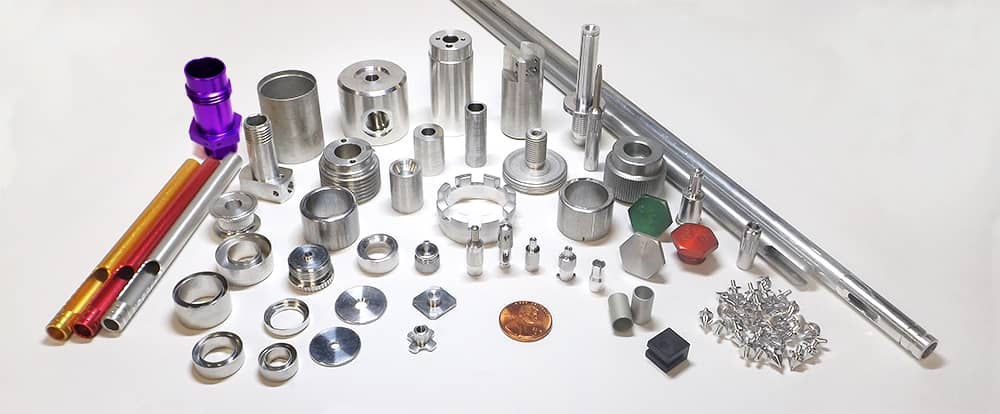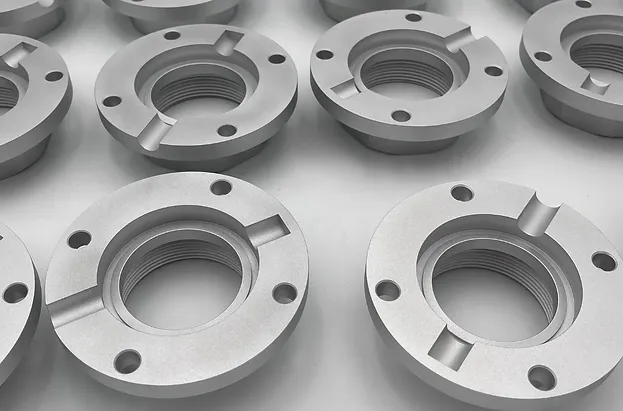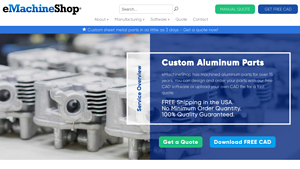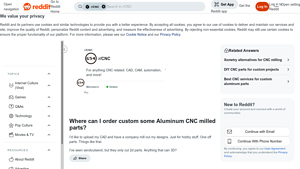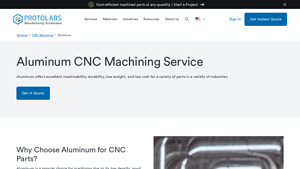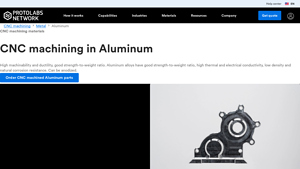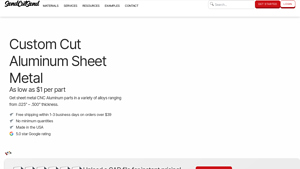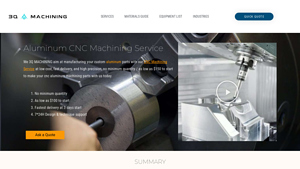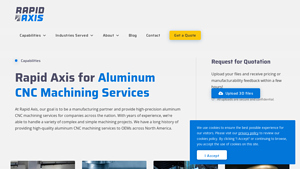Cnc Aluminum Parts Guide: Type, Cost, Top List…
Introduction: Navigating the Global Market for cnc aluminum parts
In the rapidly evolving landscape of global manufacturing, sourcing high-quality CNC aluminum parts presents both an opportunity and a challenge for international B2B buyers. With industries ranging from aerospace to automotive increasingly relying on aluminum for its lightweight and durable properties, understanding how to effectively navigate this market is crucial. This comprehensive guide delves into the diverse types of CNC aluminum parts available, their wide-ranging applications, and essential supplier vetting criteria.
As a buyer, you may face hurdles such as identifying reliable suppliers, evaluating material specifications, and managing costs while ensuring compliance with international standards. This guide aims to equip you with the knowledge needed to make informed purchasing decisions, whether you’re sourcing parts for projects in Africa, South America, the Middle East, or Europe, including regions like Saudi Arabia and Nigeria. By exploring the nuances of aluminum alloys, machining techniques, and post-manufacturing processes, you will be empowered to select the most suitable components for your specific needs.
With actionable insights and expert recommendations, this resource not only clarifies the complexities of sourcing CNC aluminum parts but also serves as a strategic tool to enhance your procurement process, ultimately driving efficiency and innovation in your operations.
Understanding cnc aluminum parts Types and Variations
| Type Name | Key Distinguishing Features | Primary B2B Applications | Brief Pros & Cons for Buyers |
|---|---|---|---|
| CNC Milling Parts | High precision, complex 3D shapes | Aerospace, automotive, medical devices | Pros: Excellent precision; versatile. Cons: Higher cost for complex designs. |
| CNC Turning Parts | Rotational machining for cylindrical shapes | Shafts, bushings, automotive components | Pros: Ideal for high-volume production; good surface finish. Cons: Limited to cylindrical shapes. |
| CNC Laser Cut Parts | Precise 2D shapes from sheets | Signage, decorative elements, enclosures | Pros: Fast and cost-effective for prototypes. Cons: Less suitable for thick materials. |
| Aluminum Extrusions | Long, uniform shapes with consistent profiles | Architectural applications, frames, railings | Pros: Cost-effective for large runs; lightweight. Cons: Limited design flexibility compared to CNC machining. |
| Aluminum Castings | Molded shapes for complex geometries | Engine components, housings, frames | Pros: Complex shapes achievable; good surface finish. Cons: Higher initial tooling costs. |
What Are CNC Milling Parts and Their B2B Relevance?
CNC milling parts are characterized by their ability to create intricate 3D shapes with high precision. This method is particularly suitable for applications in industries such as aerospace and automotive, where tight tolerances are essential. When purchasing CNC milling parts, buyers should consider the complexity of the design, as intricate features may increase costs. However, the versatility and precision of CNC milling make it an attractive option for manufacturers requiring detailed components.
How Are CNC Turning Parts Utilized in Manufacturing?
CNC turning parts are produced using lathes that shape materials into cylindrical forms. This method is ideal for creating components like shafts and bushings widely used in automotive and industrial applications. Buyers should evaluate their production volume needs, as CNC turning is efficient for high-volume runs. While offering excellent surface finishes and accuracy, buyers must note that the method is limited to rotational geometries, which can restrict design options.
What Advantages Do CNC Laser Cut Parts Offer?
CNC laser cut parts are made by using a focused laser beam to cut materials into precise 2D shapes. This technique is particularly advantageous for producing signage and decorative elements quickly and cost-effectively. Buyers looking for prototypes or short runs will find laser cutting a fast solution. However, it may not be the best choice for thicker materials, as the process is optimized for sheet metal applications.
Why Choose Aluminum Extrusions for Your Projects?
Aluminum extrusions involve shaping aluminum into long, uniform sections, making them ideal for architectural applications like frames and railings. This method is cost-effective for large production runs and offers lightweight solutions. Buyers should consider the volume of their needs, as extrusions provide consistent profiles but may have limitations in design flexibility compared to CNC machining methods.
How Do Aluminum Castings Fit into the Manufacturing Landscape?
Aluminum castings are created by pouring molten aluminum into molds, allowing for complex geometries that are often necessary in engine components and housings. This method provides excellent surface finishes and can accommodate intricate designs. However, the initial tooling costs can be significant, making it essential for buyers to assess the long-term production needs versus upfront investment. The versatility of castings can justify the costs for manufacturers requiring specific shapes and functionalities.
Key Industrial Applications of cnc aluminum parts
| Industry/Sector | Specific Application of CNC Aluminum Parts | Value/Benefit for the Business | Key Sourcing Considerations for this Application |
|---|---|---|---|
| Aerospace | Aircraft components (wings, fuselages) | Lightweight structures enhance fuel efficiency | Compliance with aviation standards, precise tolerances |
| Automotive | Engine components and chassis parts | Improved performance and reduced weight | Material certifications, machining precision |
| Electronics | Enclosures for electronic devices | Enhanced thermal management and durability | Customization options, surface finishing capabilities |
| Construction | Architectural elements (window frames) | Corrosion resistance and aesthetic appeal | Local sourcing options, ability to meet design specifications |
| Medical Devices | Surgical instruments and equipment | High precision and reliability in critical applications | Biocompatibility, adherence to regulatory standards |
How Are CNC Aluminum Parts Used in the Aerospace Industry?
CNC aluminum parts are integral to the aerospace industry, particularly in the manufacturing of aircraft components such as wings and fuselages. These parts are valued for their lightweight nature, which significantly enhances fuel efficiency and overall aircraft performance. International buyers must ensure that sourced parts comply with stringent aviation standards and possess precise tolerances to withstand the extreme conditions of flight. Additionally, understanding the specific alloy requirements, such as Aluminum 2024 or 7075, is crucial for ensuring optimal performance.
What Role Do CNC Aluminum Parts Play in the Automotive Sector?
In the automotive industry, CNC aluminum parts are widely used for engine components and chassis parts due to their excellent strength-to-weight ratio. This application leads to enhanced vehicle performance and fuel efficiency, which are critical factors in today’s competitive market. Buyers should consider sourcing aluminum parts that come with proper material certifications and are produced with high machining precision to meet the demanding specifications of modern vehicles. Additionally, understanding local regulations regarding automotive components is essential for international buyers.
How Are CNC Aluminum Parts Utilized in Electronics?
CNC aluminum parts are essential in the electronics sector, particularly for creating enclosures for electronic devices. These parts improve thermal management and provide durability, which is vital for protecting sensitive electronic components. International buyers should look for suppliers that offer customization options and advanced surface finishing capabilities to meet specific design requirements. Furthermore, ensuring that the sourcing partners can provide consistent quality and timely delivery is crucial to maintaining production schedules.
What Are the Benefits of CNC Aluminum Parts in Construction?
In the construction industry, CNC aluminum parts are used for architectural elements like window frames and facades. Their corrosion resistance and aesthetic appeal make them an ideal choice for both new constructions and renovations. Buyers from regions prone to extreme weather conditions, such as Africa and the Middle East, should prioritize local sourcing options to reduce lead times and shipping costs. Additionally, suppliers should be able to meet specific design specifications and provide options for various finishes to suit different architectural styles.
How Do CNC Aluminum Parts Enhance Medical Devices?
CNC aluminum parts are critical in the medical sector, particularly for surgical instruments and equipment. The high precision and reliability of these parts are essential in applications where safety and accuracy are paramount. Buyers must ensure that the sourced parts meet biocompatibility standards and adhere to strict regulatory requirements. Additionally, understanding the machining processes and the specific aluminum alloys suitable for medical applications can significantly impact the performance and longevity of the devices.
3 Common User Pain Points for ‘cnc aluminum parts’ & Their Solutions
Scenario 1: Navigating Quality Assurance in CNC Aluminum Parts
The Problem: B2B buyers often face the challenge of ensuring the quality of CNC aluminum parts, especially when sourcing from international suppliers. Inconsistent quality can lead to production delays, increased costs, and compromised end products. This is particularly concerning for industries such as aerospace and automotive, where precision and reliability are critical. Buyers may receive parts that do not meet specifications, leading to costly rework or scrapping of components.
The Solution: To mitigate quality assurance issues, it is essential to establish clear communication and rigorous quality standards from the outset. Buyers should request detailed specifications and certifications from suppliers, such as ISO 9001 or AS9100 for aerospace applications. Implementing a robust supplier evaluation process is crucial—this includes assessing the supplier’s manufacturing capabilities, quality control processes, and past performance. Additionally, consider arranging for third-party inspections or audits during the manufacturing process. Utilizing advanced technologies such as 3D printing for prototyping can also ensure that the final parts meet the required specifications before full-scale production begins.
Scenario 2: Overcoming Material Selection Challenges for CNC Aluminum Parts
The Problem: Selecting the right aluminum alloy for specific applications can be daunting for B2B buyers. With various grades available, such as 6061, 7075, and 5052, each with distinct properties, making an informed choice is critical. Buyers may struggle with understanding which alloy best meets their requirements for strength, weight, corrosion resistance, and machinability. Incorrect material selection can lead to performance issues and increased costs, particularly in demanding applications like automotive or aerospace.
The Solution: Buyers should invest time in thoroughly understanding the mechanical properties and suitable applications of different aluminum alloys. Collaborating with experienced engineers or material specialists can provide valuable insights into the best choices for specific use cases. Additionally, utilizing material selection software or consulting databases can help buyers compare properties side by side. When placing orders, it’s advisable to specify not just the type of aluminum but also the required certifications for the alloy to ensure compliance with industry standards. Working closely with suppliers to discuss application needs can also lead to recommendations on the most appropriate materials.
Scenario 3: Managing Lead Times and Production Scheduling for CNC Aluminum Parts
The Problem: Another significant pain point for B2B buyers is managing lead times and production schedules, especially in industries with tight timelines. Delays in obtaining CNC aluminum parts can disrupt the entire manufacturing process, leading to missed deadlines and lost business opportunities. Buyers may find it challenging to coordinate timelines with suppliers, particularly when dealing with international shipping and customs.
The Solution: To address lead time challenges, buyers should establish clear timelines and expectations upfront with suppliers. Implementing a just-in-time (JIT) inventory strategy can help manage stock levels and reduce waste, while still meeting production demands. It’s crucial to maintain open lines of communication with suppliers regarding production capabilities and potential bottlenecks. Additionally, leveraging local suppliers can significantly reduce shipping times and improve responsiveness. Buyers should also consider using digital tools for real-time tracking of orders and inventory, which can provide visibility into the production process and help mitigate delays. By planning ahead and building strong relationships with reliable suppliers, buyers can enhance their production scheduling and lead time management significantly.
Strategic Material Selection Guide for cnc aluminum parts
What Are the Key Properties of Common Aluminum Alloys for CNC Machining?
When selecting materials for CNC aluminum parts, understanding the specific properties of various aluminum alloys is crucial for ensuring optimal performance in end applications. Here, we analyze four common aluminum alloys used in CNC machining: 6061, 5052, 7075, and 2024. Each alloy has unique characteristics that influence its suitability for different applications.
How Does Aluminum 6061 Perform in CNC Machining Applications?
Aluminum 6061 is one of the most versatile and widely used aluminum alloys in CNC machining. It boasts excellent mechanical properties, good weldability, and a high strength-to-weight ratio. It performs well in a variety of environments, making it suitable for applications in automotive, aerospace, and marine industries. Its corrosion resistance is moderate, which can be enhanced with surface treatments.
Pros: The alloy’s excellent machinability and weldability make it easy to work with. It is also relatively cost-effective, making it a popular choice for many applications.
Cons: While it is strong, it may not be suitable for applications requiring extreme strength, such as high-stress aerospace components.
Impact on Application: Aluminum 6061 is ideal for structural components, frames, and supports, especially in environments where moderate corrosion resistance is acceptable.
What Are the Benefits of Using Aluminum 5052 for CNC Parts?
Aluminum 5052 is known for its exceptional corrosion resistance, particularly in marine environments, thanks to its magnesium content. This alloy is easily formed and welded, making it a favorite for sheet metal applications, including fuel tanks and marine structures.
Pros: Its high resistance to corrosion and good formability make it suitable for applications exposed to harsh environments.
Cons: Aluminum 5052 cannot be heat-treated, which limits its strength compared to other alloys. It also has a lower tensile strength than 6061.
Impact on Application: This alloy is particularly effective in applications where corrosion resistance is critical, such as in marine and automotive fuel systems.
Why Choose Aluminum 7075 for High-Strength Applications?
Aluminum 7075 is one of the strongest aluminum alloys available, primarily used in aerospace applications. It offers high fatigue strength and is suitable for components subjected to cyclic loading. However, its corrosion resistance is lower than that of other alloys, necessitating protective coatings.
Pros: The high strength-to-weight ratio makes it ideal for applications where weight savings are crucial.
Cons: It is more expensive than other aluminum alloys and can be challenging to machine due to its hardness.
Impact on Application: Aluminum 7075 is often used in aircraft structures, military vehicles, and high-stress components where strength is paramount.
What Makes Aluminum 2024 a Suitable Choice for Aerospace Applications?
Aluminum 2024 is recognized for its high strength and fatigue resistance, making it a preferred choice in aerospace applications. However, it has poor corrosion resistance and is not weldable, which limits its use in certain environments.
Pros: Its high strength and fatigue resistance make it suitable for critical structural components in aircraft.
Cons: The need for surface treatments to enhance corrosion resistance can increase manufacturing complexity and costs.
Impact on Application: Aluminum 2024 is commonly used for aircraft fittings, bolts, and other high-stress components that require superior strength.
Summary Table of Common Aluminum Alloys for CNC Machining
| Material | Typical Use Case for cnc aluminum parts | Key Advantage | Key Disadvantage/Limitation | Relative Cost (Low/Med/High) |
|---|---|---|---|---|
| Aluminum 6061 | Structural components, frames | Excellent machinability and weldability | Moderate corrosion resistance | Medium |
| Aluminum 5052 | Marine applications, fuel tanks | Exceptional corrosion resistance | Lower tensile strength than 6061 | Medium |
| Aluminum 7075 | Aerospace structures, military vehicles | High strength-to-weight ratio | Poor corrosion resistance | High |
| Aluminum 2024 | Aircraft fittings, high-stress parts | High strength and fatigue resistance | Poor corrosion resistance and non-weldable | Medium |
This strategic material selection guide provides international B2B buyers with essential insights into aluminum alloys, helping them make informed decisions based on application requirements, cost considerations, and regional compliance standards.
In-depth Look: Manufacturing Processes and Quality Assurance for cnc aluminum parts
What Are the Typical Manufacturing Processes for CNC Aluminum Parts?
Manufacturing CNC aluminum parts involves a systematic process that ensures precision, quality, and efficiency. The primary stages include material preparation, forming, assembly, and finishing, each employing specific techniques to produce high-quality components.
How Is Material Prepared for CNC Machining?
The first step in manufacturing CNC aluminum parts is material preparation. High-quality aluminum, often in the form of sheets, blocks, or extrusions, is selected based on the required properties for the final product. Commonly used aluminum alloys include 6061, 5052, and 7075, each offering distinct mechanical properties suitable for different applications.
Once the material is selected, it undergoes inspection to verify its dimensions, surface quality, and alloy specifications. This initial quality check is crucial to prevent defects during later stages. After inspection, the material is cut to size using techniques such as shearing or sawing, ensuring that it meets the specifications outlined in the design phase.
What Forming Techniques Are Used in CNC Machining?
Forming is the core of CNC machining, where the prepared material is shaped into the desired component using various techniques. The most common methods include:
-
CNC Milling: This technique involves using rotating cutting tools to remove material from the workpiece, creating complex shapes and features. CNC milling is known for its precision and ability to achieve tight tolerances.
-
CNC Turning: In this process, the workpiece is rotated while cutting tools are applied to shape it into cylindrical forms. This method is ideal for producing parts like shafts and rings.
-
Waterjet Cutting: Suitable for creating intricate designs, waterjet cutting utilizes a high-pressure stream of water mixed with abrasive materials. It is particularly effective for cutting thick aluminum sheets without altering their properties.
-
EDM (Electrical Discharge Machining): This technique uses electrical sparks to erode material, making it perfect for creating complex shapes with high dimensional accuracy.
-
Laser Cutting: Employed for producing 2D shapes from aluminum sheets, laser cutting provides clean edges and is efficient for prototypes and short production runs.
What Are the Key Assembly Processes for CNC Aluminum Parts?
After forming, assembly processes may be required, especially for complex components that consist of multiple parts. Common assembly techniques include:
-
Welding: Certain aluminum alloys can be welded, allowing for the joining of multiple components. Proper welding techniques must be employed to maintain the strength and corrosion resistance of the parts.
-
Fastening: Mechanical fasteners such as screws, bolts, and rivets are often used to assemble parts that cannot be welded. Choosing the right fastening method is crucial for maintaining structural integrity.
-
Adhesives: In some cases, adhesives are used to bond aluminum parts, particularly in applications where welding is impractical or could compromise the material properties.
How Are Finishing Processes Applied to CNC Aluminum Parts?
Finishing processes enhance the aesthetic appeal and performance of CNC aluminum parts. Common finishing techniques include:
-
Anodizing: This electrochemical process increases corrosion resistance and allows for dyeing in various colors, which can be beneficial for branding and aesthetics.
-
Powder Coating: A popular finishing method that provides a durable, high-quality finish, powder coating can also enhance corrosion resistance.
-
Polishing: This process improves surface smoothness and shine, which is particularly important for components visible in consumer-facing products.
-
Surface Treatments: Additional treatments, such as plating or passivation, may be applied to further enhance corrosion resistance or surface durability.
What Quality Assurance Practices Are Essential for CNC Aluminum Parts?
Quality assurance (QA) is critical in the manufacturing of CNC aluminum parts, ensuring that products meet specified standards and customer requirements. Effective QA practices include adherence to international standards and rigorous inspection protocols throughout the manufacturing process.
Which International Standards Should CNC Aluminum Parts Meet?
International standards such as ISO 9001 provide a framework for quality management systems, ensuring consistent product quality and customer satisfaction. Additionally, industry-specific standards such as CE marking for European markets and API standards for the oil and gas industry may apply, depending on the intended application of the aluminum parts.
What Are the Key Quality Control Checkpoints During Manufacturing?
Quality control (QC) checkpoints are integrated at various stages of the manufacturing process to detect and address issues early:
-
Incoming Quality Control (IQC): This initial inspection verifies that raw materials meet specifications before they enter the production process.
-
In-Process Quality Control (IPQC): During machining, regular inspections are conducted to monitor dimensional accuracy and detect any deviations from specifications.
-
Final Quality Control (FQC): After finishing, a comprehensive inspection assesses the final product against design specifications, ensuring it meets all quality standards before shipment.
What Common Testing Methods Are Used to Ensure Quality?
Several testing methods are employed to validate the quality of CNC aluminum parts, including:
-
Dimensional Inspection: Using calipers and micrometers to measure key dimensions and tolerances.
-
Visual Inspection: Checking for surface defects, such as scratches, dents, or improper finishes.
-
Mechanical Testing: Conducting tensile tests, hardness tests, and fatigue tests to verify material properties.
-
Non-Destructive Testing (NDT): Techniques such as ultrasonic testing or dye penetrant inspection are used to detect internal flaws without damaging the part.
How Can B2B Buyers Verify Supplier Quality Control Practices?
B2B buyers must ensure that their suppliers maintain rigorous quality control practices. This can be achieved through several methods:
-
Supplier Audits: Conducting on-site audits allows buyers to evaluate the supplier’s quality management system, production capabilities, and adherence to standards.
-
Quality Assurance Reports: Requesting detailed QA reports, including inspection results and compliance certifications, can provide insights into the supplier’s quality practices.
-
Third-Party Inspections: Engaging third-party inspection services can provide an unbiased assessment of the supplier’s quality control processes and product quality.
What Are the Quality Control Nuances for International B2B Buyers?
International buyers, particularly from regions such as Africa, South America, the Middle East, and Europe, should be aware of specific nuances in quality control. Cultural differences, regulatory requirements, and logistical challenges may affect the quality assurance process. It is advisable for buyers to establish clear communication channels, define quality expectations upfront, and consider local regulations that may impact product specifications and testing requirements.
By understanding the manufacturing processes and quality assurance practices for CNC aluminum parts, B2B buyers can make informed decisions, ensuring they receive high-quality products that meet their specific needs.
Practical Sourcing Guide: A Step-by-Step Checklist for ‘cnc aluminum parts’
To effectively source CNC aluminum parts, international B2B buyers must follow a structured approach to ensure quality, compliance, and cost-effectiveness. This guide provides a practical checklist that outlines essential steps for successful procurement.
Step 1: Define Your Technical Specifications
Clearly outline the specifications for the CNC aluminum parts you need. This includes dimensions, tolerances, and material grades. Having precise technical requirements helps suppliers understand your needs and reduces the risk of costly errors.
- Consider the intended application to determine the appropriate aluminum alloy (e.g., 6061 for general use, 7075 for high-strength applications).
- Specify any surface treatments or finishes required, such as anodizing or powder coating, to enhance durability.
Step 2: Identify Potential Suppliers
Research and create a list of potential suppliers specializing in CNC aluminum machining. This can include manufacturers from various regions, particularly those with a strong reputation in your target markets like Africa or Europe.
- Utilize online platforms, industry directories, and trade shows to discover reliable suppliers.
- Look for suppliers with experience in your specific industry to ensure they understand your unique requirements.
Step 3: Evaluate Supplier Capabilities
Assess the technical capabilities of each potential supplier. This involves reviewing their machinery, technology, and production processes to ensure they can meet your specifications.
- Inquire about their CNC machining technologies (e.g., milling, turning, waterjet cutting) and how they align with your needs.
- Check if they offer secondary manufacturing processes, such as surface finishing and assembly, to streamline your supply chain.
Step 4: Verify Quality Standards
Quality assurance is critical in sourcing CNC aluminum parts. Confirm that potential suppliers adhere to international quality standards, such as ISO 9001.
- Request documentation of their quality management system and any relevant certifications.
- Ask for samples or references from previous clients to gauge the quality of their work.
Step 5: Request Quotes and Compare Pricing
Once you have identified qualified suppliers, request detailed quotes. Ensure that the quotes include all relevant costs, such as tooling, machining, finishing, and shipping.
- Compare quotes not just on price but also on delivery times and payment terms.
- Consider long-term relationships with suppliers who offer competitive pricing and reliability.
Step 6: Negotiate Terms and Conditions
Engage in negotiations with your chosen supplier to finalize terms and conditions. This includes pricing, lead times, and payment terms, ensuring both parties are clear on expectations.
- Discuss any potential discounts for bulk orders or long-term contracts.
- Establish clear communication channels for updates and problem resolution during production.
Step 7: Conduct a Final Review Before Order Placement
Before placing your order, conduct a final review of all specifications, terms, and supplier capabilities. This step is crucial to avoid misunderstandings and ensure a smooth production process.
- Confirm that all technical specifications are documented and understood by the supplier.
- Ensure that you have a clear plan for logistics and delivery to minimize disruptions.
By following this comprehensive sourcing checklist, B2B buyers can navigate the complexities of procuring CNC aluminum parts, ensuring they receive high-quality products that meet their operational needs.
Comprehensive Cost and Pricing Analysis for cnc aluminum parts Sourcing
What Are the Key Cost Components for CNC Aluminum Parts?
Understanding the cost structure for CNC aluminum parts is crucial for international B2B buyers. The primary cost components include:
-
Materials: The choice of aluminum alloy significantly influences material costs. Common alloys like 6061 and 5052 are generally less expensive compared to high-strength options like 7075 or 7050. Prices may also fluctuate based on global aluminum market trends.
-
Labor: Labor costs encompass machining, assembly, and finishing processes. Regions with lower labor costs can offer competitive pricing, but it’s essential to balance this with the skill level and expertise required for precision machining.
-
Manufacturing Overhead: This includes costs related to facility maintenance, utilities, and equipment depreciation. Efficient production processes can help minimize overhead, thus reducing overall costs.
-
Tooling: Tooling costs can be significant, especially for custom parts. These include the expenses for specialized tools and fixtures required for machining. Investing in durable tooling can lead to long-term savings through increased efficiency and reduced changeover times.
-
Quality Control (QC): Ensuring product quality involves inspection and testing, which incur additional costs. Buyers should inquire about the supplier’s QC processes and certifications, as these can affect pricing and part reliability.
-
Logistics: Shipping costs, including freight, insurance, and customs duties, can vary widely based on destination and Incoterms. Understanding these costs is vital for accurate budgeting.
-
Margin: Suppliers typically apply a profit margin to cover their risks and operational costs. This margin can vary based on competition, market demand, and the supplier’s pricing strategy.
How Do Pricing Influencers Affect CNC Aluminum Parts Costs?
Several factors can influence the pricing of CNC aluminum parts:
-
Volume and Minimum Order Quantity (MOQ): Higher order volumes typically lead to lower per-unit costs due to economies of scale. Buyers should negotiate MOQs that align with their needs to avoid excess inventory.
-
Specifications and Customization: Parts requiring unique specifications or custom designs may incur higher costs due to additional machining time and tooling adjustments.
-
Materials and Quality Certifications: The choice of material and the need for specific quality certifications (e.g., ISO, AS9100) can significantly influence pricing. Higher-quality materials or certified processes often come at a premium.
-
Supplier Factors: The supplier’s location, reputation, and production capabilities can affect pricing. Established suppliers with a proven track record may charge higher prices but offer reliability and superior service.
-
Incoterms: The agreed Incoterms can impact overall costs. Terms like DDP (Delivered Duty Paid) may include additional expenses compared to FOB (Free on Board), where the buyer assumes responsibility for shipping.
What Are the Best Buyer Tips for Cost-Efficiency in CNC Aluminum Parts Sourcing?
For B2B buyers, particularly from regions like Africa, South America, the Middle East, and Europe, the following tips can enhance cost-efficiency:
-
Negotiate Terms: Always negotiate pricing and payment terms. Building a long-term relationship with suppliers can lead to better pricing and priority service.
-
Consider Total Cost of Ownership (TCO): Evaluate the TCO, which includes not just the purchase price but also shipping, handling, and potential maintenance costs. A lower initial price might not always equate to lower overall expenses.
-
Understand Pricing Nuances: Familiarize yourself with the regional market dynamics. Prices can vary significantly based on local demand, currency fluctuations, and geopolitical factors.
-
Utilize Technology: Take advantage of online quoting tools and CAD software provided by suppliers. This can streamline the design process and provide quick cost estimates, facilitating better decision-making.
-
Request Samples: Before placing large orders, request samples to assess quality and fit. This can prevent costly mistakes and ensure that the product meets your specifications.
Disclaimer on Indicative Prices
Pricing for CNC aluminum parts can vary widely based on the factors discussed above. Buyers should conduct thorough research and obtain multiple quotes to ensure they receive competitive pricing tailored to their specific needs.
Alternatives Analysis: Comparing cnc aluminum parts With Other Solutions
Introduction: Why Consider Alternatives to CNC Aluminum Parts?
When evaluating manufacturing solutions, it’s vital to consider various alternatives to CNC aluminum parts. While aluminum is renowned for its lightweight properties and excellent strength-to-weight ratio, other materials and methods may offer advantages in specific applications. This analysis compares CNC aluminum parts against two viable alternatives: 3D printing with polymers and CNC machining with steel. Understanding the strengths and weaknesses of each can guide B2B buyers in making informed decisions that align with their operational needs.
Comparison Table
| Comparison Aspect | CNC Aluminum Parts | 3D Printing with Polymers | CNC Machining with Steel |
|---|---|---|---|
| Performance | High strength, lightweight; ideal for structural applications | Good for complex geometries but lower strength than metals | High strength and durability; excellent for heavy-duty applications |
| Cost | Moderate to high; dependent on complexity and volume | Generally lower for low volumes; costs can rise with complexity | Higher initial setup costs; cost-effective for high volumes |
| Ease of Implementation | Requires CAD design and machining expertise | User-friendly; often requires minimal training | Requires skilled operators; setup can be time-consuming |
| Maintenance | Low; aluminum is corrosion-resistant | Moderate; depends on material used and application | High; steel can corrode and requires regular maintenance |
| Best Use Case | Aerospace, automotive parts, and applications requiring precision | Prototyping, custom designs, and low-volume production | Heavy machinery, structural components, and applications needing high durability |
Detailed Breakdown of Alternatives
3D Printing with Polymers
3D printing offers significant advantages for custom designs and rapid prototyping. It allows for the creation of complex geometries that would be difficult or impossible to achieve with traditional machining methods. However, while 3D-printed parts can be produced quickly and at lower costs for small runs, they typically lack the mechanical strength of CNC aluminum parts, making them less suitable for applications that require high structural integrity. Additionally, the variety of available polymers can vary in durability and heat resistance, which may limit their use in demanding environments.
CNC Machining with Steel
CNC machining with steel is an alternative that provides exceptional strength and durability, making it ideal for heavy-duty applications such as machinery components and structural parts. Steel components can withstand extreme conditions and offer longevity. However, the cost of CNC machining with steel can be higher due to the need for more robust tools and the increased complexity of machining processes. Additionally, the weight of steel parts can be a disadvantage in applications where weight reduction is a priority, such as in the aerospace and automotive sectors.
Conclusion: How to Choose the Right Manufacturing Solution
Selecting the right manufacturing solution depends on various factors, including specific application requirements, budget constraints, and desired performance characteristics. For B2B buyers, it is crucial to evaluate the trade-offs between CNC aluminum parts, 3D printing with polymers, and CNC machining with steel. Considerations such as the intended use, volume of production, and material properties will guide the decision-making process. By aligning these factors with the capabilities of each alternative, buyers can make informed choices that enhance their operational efficiency and product performance.
Essential Technical Properties and Trade Terminology for cnc aluminum parts
What Are the Critical Technical Properties of CNC Aluminum Parts?
When sourcing CNC aluminum parts, understanding their technical properties is essential for ensuring that they meet specific application requirements. Here are some critical specifications to consider:
1. Material Grade
Material grade refers to the specific alloy of aluminum used in manufacturing. Common grades include 6061, 5052, and 7075, each offering different mechanical properties. For instance, 6061 is well-known for its versatility and weldability, making it suitable for various industries, while 7075 is favored for its high strength in aerospace applications. Selecting the right grade is crucial for ensuring the durability and performance of the final product.
2. Tolerance
Tolerance defines the allowable deviation from specified dimensions in the machining process. Tight tolerances (e.g., ±0.001 inches) are critical in high-precision applications like aerospace and medical devices, where even minor deviations can lead to significant failures. Understanding tolerance requirements helps buyers communicate effectively with manufacturers, ensuring that parts fit and function as intended.
3. Surface Finish
Surface finish refers to the texture and treatment of the aluminum parts after machining. Common finishes include anodizing, powder coating, and polishing. Each finish serves a specific purpose, such as improving corrosion resistance or enhancing aesthetic appeal. Buyers should specify their desired surface finish based on the part’s intended environment and use, as it can significantly affect performance and longevity.
4. Mechanical Properties
Key mechanical properties such as tensile strength, yield strength, and elongation are vital indicators of how a material will perform under stress. For example, aluminum 6061 has a yield strength of around 276 MPa, making it suitable for structural applications. Understanding these properties helps buyers select the right materials for their projects, ensuring reliability and safety.
5. Machinability
Machinability indicates how easily a material can be cut or shaped during the manufacturing process. Aluminum is generally known for good machinability, but specific alloys can vary significantly. For example, 2024 aluminum has excellent machinability but is not weldable. Understanding machinability helps buyers make informed decisions about the manufacturing processes that will be employed.
What Are Common Trade Terms in CNC Aluminum Parts Manufacturing?
Familiarity with industry jargon is essential for effective communication and negotiation. Here are some common terms you should know:
1. OEM (Original Equipment Manufacturer)
OEM refers to a company that produces parts or equipment that may be marketed by another manufacturer. In the context of CNC aluminum parts, OEMs often require custom components for assembly into their final products. Understanding OEM dynamics can help buyers identify suitable suppliers for their specific needs.
2. MOQ (Minimum Order Quantity)
MOQ is the smallest quantity of a product that a supplier is willing to sell. This term is crucial for budget-conscious buyers, as some manufacturers may require larger orders to maintain profitability. Knowing the MOQ helps buyers plan their purchasing strategies and avoid excess inventory.
3. RFQ (Request for Quotation)
An RFQ is a document sent to suppliers to request pricing for specific quantities of parts or services. It typically includes detailed specifications, tolerances, and other requirements. Utilizing RFQs can streamline the procurement process, allowing buyers to compare quotes from multiple suppliers efficiently.
4. Incoterms (International Commercial Terms)
Incoterms are internationally recognized rules that define the responsibilities of buyers and sellers in international transactions. They clarify who is responsible for shipping, insurance, and tariffs. Understanding these terms is essential for buyers involved in cross-border transactions to avoid misunderstandings and ensure smooth delivery.
5. CNC Machining
CNC (Computer Numerical Control) machining is a manufacturing process that uses computer-controlled tools to create precise parts from raw materials. This technology is critical for producing complex shapes and maintaining tight tolerances. Understanding CNC machining capabilities enables buyers to select the right processes for their specific part requirements.
Understanding these technical properties and trade terms will empower B2B buyers to make informed decisions when sourcing CNC aluminum parts, ultimately enhancing project outcomes and operational efficiency.
Navigating Market Dynamics and Sourcing Trends in the cnc aluminum parts Sector
What Are the Current Trends Shaping the CNC Aluminum Parts Market?
The CNC aluminum parts market is experiencing significant growth due to several global drivers. Increasing demand across various sectors such as aerospace, automotive, and construction is propelling the market forward. Notably, the aerospace industry’s shift towards lightweight materials to improve fuel efficiency is a primary catalyst. Additionally, the automotive sector’s push for electric vehicles is increasing the need for lightweight components, where aluminum’s strength-to-weight ratio becomes invaluable.
Emerging technologies such as Industry 4.0 are revolutionizing the sourcing and production processes. Automation and advanced CNC machining techniques allow for greater precision, reduced lead times, and lower production costs. Furthermore, the rise of online platforms for instant quoting and manufacturing services simplifies the sourcing process for international buyers, enabling quicker decision-making and streamlined procurement.
In terms of market dynamics, international B2B buyers, particularly from regions like Africa, South America, the Middle East, and Europe, should be mindful of the growing trend towards customization. Manufacturers are increasingly offering tailored solutions to meet specific client needs, which can enhance competitiveness in various industries. The integration of digital tools for design and collaboration is also becoming essential, allowing buyers to visualize their requirements and obtain faster turnaround times.
How Can B2B Buyers Address Sustainability and Ethical Sourcing in CNC Aluminum Parts?
Sustainability and ethical sourcing have become pivotal in the CNC aluminum parts sector. The environmental impact of aluminum production is significant, as it involves high energy consumption and greenhouse gas emissions. Consequently, international buyers are increasingly prioritizing suppliers who demonstrate commitment to sustainable practices. This includes using recycled aluminum, which not only reduces the carbon footprint but also decreases energy usage by up to 95% compared to primary aluminum production.
The importance of ethical supply chains cannot be overstated. Buyers are encouraged to conduct due diligence on their suppliers, ensuring that they adhere to fair labor practices and environmental regulations. Certifications such as ISO 14001 (Environmental Management) and ISO 45001 (Occupational Health and Safety) are indicators of a supplier’s commitment to sustainable practices.
Additionally, the use of “green” materials is gaining traction. Buyers should look for suppliers that offer aluminum alloys with reduced environmental impact, as well as eco-friendly surface finishing options like anodizing or powder coating, which are less harmful than traditional methods. This not only enhances brand reputation but also meets the growing consumer demand for sustainable products.
What Is the Historical Context of CNC Aluminum Parts for B2B Buyers?
The history of aluminum as a material for manufacturing dates back to the late 19th century, but its industrial application surged in the early 20th century, particularly during World War I and II when lightweight, strong materials became essential for military applications. The introduction of CNC machining in the 1960s transformed the production landscape, allowing for high-precision manufacturing of complex aluminum parts.
Over the decades, advancements in aluminum alloy formulations and machining technologies have led to the development of specialized alloys tailored for specific applications, enhancing performance in sectors ranging from aerospace to automotive. The evolution of CNC technology has made it possible for manufacturers to produce intricate designs with unparalleled accuracy and efficiency, solidifying aluminum’s role as a material of choice in modern manufacturing.
As international B2B buyers navigate the current landscape, understanding this historical context can provide valuable insights into the capabilities and innovations available in the CNC aluminum parts market today.
Frequently Asked Questions (FAQs) for B2B Buyers of cnc aluminum parts
-
How do I choose the right aluminum alloy for my CNC parts?
Selecting the appropriate aluminum alloy depends on your specific application requirements. Common alloys include 6061 for general-purpose uses, 5052 for marine applications due to its corrosion resistance, and 7075 for aerospace components needing high strength. Consider factors such as strength, weight, corrosion resistance, and machinability. Consulting with your supplier can also provide insights into which alloy best meets your performance criteria and budget constraints. -
What are the common machining processes for CNC aluminum parts?
CNC machining processes for aluminum parts typically include milling, turning, waterjet cutting, and laser cutting. Milling is ideal for creating complex 3D shapes with tight tolerances, while turning is best for cylindrical components. Waterjet and laser cutting are excellent for producing precise 2D shapes. Understanding these processes will help you select the right method based on your design specifications and production volume. -
What is the minimum order quantity (MOQ) for CNC aluminum parts?
Minimum order quantities can vary significantly between suppliers, often influenced by the complexity of the part and the machining process required. Some manufacturers may have no MOQ, allowing for the production of single prototypes, while others may require larger orders to ensure cost-effectiveness. Always confirm MOQs with your supplier to align your production needs with their capabilities. -
How can I ensure quality assurance in my CNC aluminum parts?
To ensure the quality of your CNC aluminum parts, choose suppliers who adhere to recognized quality standards, such as ISO certifications. Request samples or prototypes before placing large orders to assess their workmanship. Additionally, inquire about their quality control processes, including inspection methods and testing protocols, to ensure that the final products meet your specifications. -
What payment terms should I expect when sourcing CNC aluminum parts internationally?
Payment terms can vary based on the supplier’s policies and the nature of your business relationship. Common arrangements include upfront deposits, payment upon delivery, or net terms (e.g., 30 or 60 days). It’s advisable to negotiate terms that suit your cash flow while considering the supplier’s requirements. Always ensure that any payment terms are clearly documented in your contract to avoid misunderstandings. -
How do I vet a supplier for CNC aluminum parts?
Vetting a supplier involves researching their reputation, capabilities, and experience. Look for customer reviews, case studies, and industry certifications. Request references and visit their manufacturing facilities, if possible, to evaluate their operations. Additionally, assess their responsiveness and willingness to collaborate on your specific project needs, as these factors are indicative of their reliability and professionalism. -
What are the shipping options for CNC aluminum parts, and how do they impact costs?
Shipping options typically include air freight for faster delivery or sea freight for cost-effective bulk shipping. The choice of shipping method will depend on your timeline and budget. While air freight is quicker, it can significantly increase costs, especially for larger shipments. Always discuss logistics with your supplier to find the best shipping solution that balances speed and expense. -
How can I customize my CNC aluminum parts?
Customization of CNC aluminum parts can be achieved through various means, including altering dimensions, finishes, and materials. Many suppliers offer design assistance, allowing you to upload your CAD files or use their design tools to create tailored components. Discuss your specific requirements with the supplier to explore available customization options, including surface treatments like anodizing or powder coating, to enhance durability and aesthetics.
Important Disclaimer & Terms of Use
⚠️ Important Disclaimer
The information provided in this guide, including content regarding manufacturers, technical specifications, and market analysis, is for informational and educational purposes only. It does not constitute professional procurement advice, financial advice, or legal advice.
While we have made every effort to ensure the accuracy and timeliness of the information, we are not responsible for any errors, omissions, or outdated information. Market conditions, company details, and technical standards are subject to change.
B2B buyers must conduct their own independent and thorough due diligence before making any purchasing decisions. This includes contacting suppliers directly, verifying certifications, requesting samples, and seeking professional consultation. The risk of relying on any information in this guide is borne solely by the reader.
Top 8 Cnc Aluminum Parts Manufacturers & Suppliers List
1. eMachineShop – Custom CNC Aluminum Parts
Domain: emachineshop.com
Registered: 1999 (26 years)
Introduction: Custom CNC Aluminum Parts Machining Service Overview: eMachineShop has over 15 years of experience in machining aluminum parts. Key features include:
– Free CAD software for design and ordering or the option to upload your own CAD file for a fast quote.
– FREE Shipping in the USA.
– No Minimum Order Quantity.
– 100% Quality Guaranteed.
Aluminum Properties:
– Lightweight, non-magnetic, silve…
2. Reddit – Custom Aluminum CNC Milled Parts
Domain: reddit.com
Registered: 2005 (20 years)
Introduction: Custom aluminum CNC milled parts, one-off designs, CAD upload for milling, hobby projects, companies mentioned include Xometry and SendCutSend.
3. Protolabs – Aluminum CNC Machining Service
Domain: protolabs.com
Registered: 2006 (19 years)
Introduction: Aluminum CNC Machining Service offers cost-efficient machined parts at any quantity. Key benefits of aluminum include excellent machinability, high strength and hardness, heat tolerance, corrosion resistance, electrical conductivity, overall versatility, and low cost. Common aluminum alloys used are 6061-T651, 7075-T651, and 2024-T351, each providing a balance of strength, machinability, and cost….
4. Hubs – CNC Machined Aluminum Parts
Domain: hubs.com
Registered: 1998 (27 years)
Introduction: CNC Machining Aluminum Services: High machinability and ductility, good strength-to-weight ratio. Aluminum alloys have good strength-to-weight ratio, high thermal and electrical conductivity, low density, and natural corrosion resistance. Can be anodized. Order CNC machined Aluminum parts. Materials include Aluminum 6061-T6, Aluminum 7075-T6, Aluminum 6060, Aluminum 6082, Aluminum 5083-H111, Alumi…
5. PCBWay – CNC Machining in Aluminum Alloys
Domain: pcbway.com
Registered: 2012 (13 years)
Introduction: CNC machining in Aluminum includes various aluminum alloys such as Aluminum 6061, Aluminum 7075, Aluminum 5052, and Aluminum 2A12. Each alloy has specific properties:
– Aluminum 6061: Popular alloy with good strength-to-weight ratio, excellent machinability, and natural corrosion resistance.
– Aluminum 7075: Aerospace-grade material known for its excellent strength-to-weight ratio and comparable…
6. SendCutSend – Custom Aluminum Laser Cut Parts
Domain: sendcutsend.com
Registered: 2015 (10 years)
Introduction: Custom aluminum laser cut parts in various alloys with thicknesses ranging from .025″ to .500″. Free shipping within 2-4 business days, no minimum quantities, made in the USA. Material certifications available. Four aluminum alloys offered: 2024, 5052, 6061, and 7075, each with specific strength, weldability, corrosion resistance, toughness, formability, machinability, heat treating, and strength-…
7. 3Q Machining – Custom Aluminum CNC Parts
Domain: 3qmachining.com
Registered: 2020 (5 years)
Introduction: 3Q Machining offers Aluminum CNC Machining services for custom aluminum parts with the following key details:
– **No Minimum Quantity**: Orders can start from 1 piece.
– **Pricing**: Projects start as low as $100.
– **Fast Delivery**: Lead time as fast as 3 days for rapid prototypes.
– **Precision Tolerance**: As low as +/- 0.005 mm with a drawing; ISO 2768 medium without a drawing.
– **Commo…
8. Rapid Axis – Aluminum CNC Machining Services
Domain: rapidaxis.com
Registered: 2018 (7 years)
Introduction: Aluminum CNC Machining Service | Custom Parts | Rapid Axis offers high-precision aluminum CNC machining services for various industries including aerospace, automotive, medical, electronics, and robotics. Key features include:
– Custom aluminum CNC machining for complex and simple projects.
– Parts made to customer drawing tolerances with quick lead times.
– Available aluminum alloys: 6061, 7075, …
Strategic Sourcing Conclusion and Outlook for cnc aluminum parts
In summary, strategic sourcing of CNC aluminum parts is crucial for international buyers seeking to enhance their supply chain efficiency and product quality. Understanding the diverse properties and applications of various aluminum alloys, such as 6061 and 7075, allows businesses to select the right materials that meet their specific operational needs. The lightweight nature and exceptional strength-to-weight ratio of aluminum make it an ideal choice across industries, from aerospace to automotive, thereby driving innovation and cost savings.
Buyers should leverage the benefits of working with reputable suppliers who offer flexible order quantities and comprehensive machining options, including CNC milling, turning, and advanced finishing processes. This adaptability not only ensures high-quality production but also supports rapid prototyping and customization, which are essential in today’s fast-paced market.
Looking ahead, the demand for CNC aluminum parts is expected to grow, particularly in regions like Africa, South America, the Middle East, and Europe. As industries evolve, embracing strategic sourcing will empower businesses to stay competitive and meet emerging challenges. Engage with trusted suppliers today to unlock the potential of CNC aluminum parts in your projects and drive your business forward.
